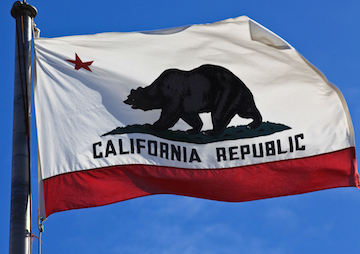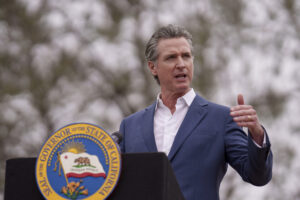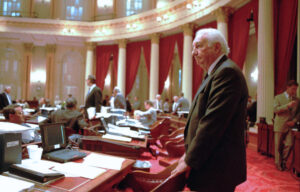Bank of North Dakota Soars Despite Oil Bust: A Blueprint for California?
Despite North Dakota’s collapsing oil market, its state-owned bank continues to report record profits. With 50 times North Dakota’s population, California could do the same. Hakan Dahlstrom / CC-BY-2.0
1
2
Hakan Dahlstrom / CC-BY-2.0
1
2
Assume that from its $5.5 billion in profits, the bank then repaid the pension funds their $1 billion initial capital investment. That would leave $4.5 billion in profit, free and clear – a tidy sum potentially generated by one man sitting in an office shuffling computer entries, without new buildings, tellers, loan officers or other overhead. That capital base would be sufficient to capitalize about $40 billion in new loans, all generated without cost to the taxpayers.
A California New Deal
The bullet train example is a simple way to illustrate the potential of a state-owned bank, but there are many other possibilities for using its available assets. As the BND did after building up its capital base, the bank could advance loans at reasonable rates for local businesses, homeowners, students, school districts, and municipalities seeking funds for infrastructure.
These loans would be somewhat riskier than buying back the state’s own bonds, and they would involve variable time frames. Like all banks, the state bank could run into liquidity problems from borrowing short to lend long, should the depositors unexpectedly come for their money. But again, that problem could be fixed simply by liquidating some portion of the money remaining in the PMIA and depositing it in the state-owned bank, where it would earn the same 0.5% interest it is earning now.
Here is another intriguing possibility for avoiding liquidity problems. The bank could serve simply as intermediator, generating loans which would then be sold to investors. That is what banks do today when they securitize mortgages and sell them off. Risk of loss is imposed on the investors, who also get the payment stream; but the bank profits as well, by receiving fees for its intermediating functions.
The federally-owned Reconstruction Finance Corporation (RFC) did something similar when it funded a major portion of the New Deal and World War II by selling bonds. This money was then used for loans to build infrastructure of every sort and to finance the war. According to a US Treasury report titled Final Report of the Reconstruction Finance Corporation (Government Printing Office, 1959), the RFC loaned or invested more than $40 billion from 1932 to 1957 (the years of its operation). By some estimates, the sum was about $50 billion. A small part of this came from its initial capitalization. The rest was borrowed – $51.3 billion from the US Treasury and $3.1 billion from the public. The RFC financed roads, bridges, dams, post offices, universities, electrical power, mortgages, farms, and much more, while at the same time making money for the government. On its normal lending functions (omitting such things as extraordinary grants for wartime), it wound up earning a total net income of $690 million.
North Dakota has led the way in demonstrating how a state can jump-start a flagging economy by keeping its revenues in its own state-owned bank, using them to generate credit for the state and its citizens, bypassing the tourniquet on the free flow of credit imposed by private out-of-state banks. California and other states could do the same. They could create jobs, restore home ownership, rebuild infrastructure and generally stimulate their economies, while generating hefty dividends for the state, without increasing debt levels or risking public funds – and without costing taxpayers a dime.
__________________
Ellen Brown is an attorney and author of twelve books, including the best-selling Web of Debt. Her latest book, The Public Bank Solution, explores successful public banking models historically and globally. Her 300+ blog articles are at EllenBrown.com. She can be heard biweekly on “It’s Our Money with Ellen Brown” on PRN.FM.
Your support matters…Independent journalism is under threat and overshadowed by heavily funded mainstream media.
You can help level the playing field. Become a member.
Your tax-deductible contribution keeps us digging beneath the headlines to give you thought-provoking, investigative reporting and analysis that unearths what's really happening- without compromise.
Give today to support our courageous, independent journalists.








You need to be a supporter to comment.
There are currently no responses to this article.
Be the first to respond.